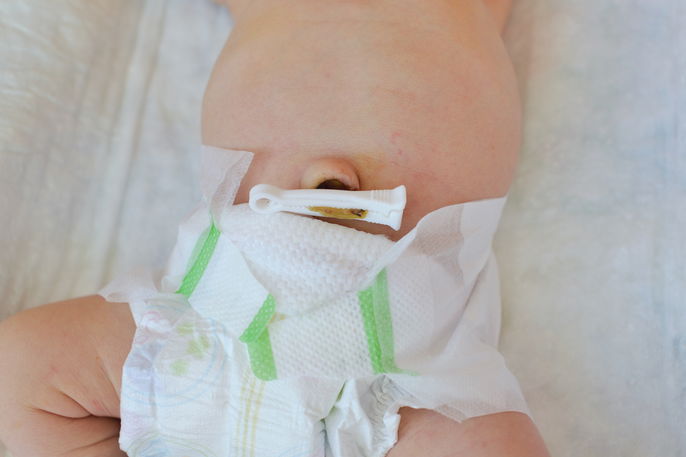Umbilical cord stump care is essential for reducing the newborn's risk for infections and inflammation in the belly button area. While umbilical cord stump remains attached to the baby after birth, it will naturally fall off up until about the third week of life. Until it falls off, parents and caregivers should keep the umbilical stump clean and dry.
It is common for the umbilical cord stump to appear gelatinous, moist and shiny, and to have a white or yellow color. It will then become dry, hardened and black as the days go by.
It is important to consult a pediatrician if the newborn's umbilical cord stump develops yellow discharge or if the skin around it becomes red, as these are signs of infection.

How to clean an umbilical cord
It is important to only give the baby sponge baths until the stump falls off. Soaking the umbilical cord stump in bath water can increase the risk for infection.
The umbilical cord stump only requires cleaning once a day, unless it becomes soiled.
To clean the umbilical cord stump, you will only need (1) a clean piece of gauze soaked with clean water and (2) a dry piece of gauze.
Start by washing and drying your hands thoroughly. Hold the tip of the stump or the clamp with your non-dominant index finger and thumb. With your dominant hand, take the soaked piece of gauze and dab the stump lightly, starting from the base and working your way up to the tip. Be sure to dab the stump very lightly, and to not tug at the stump. Once you are done, take the dry piece of gauze and dry the stump, again using very light pressure.
Keeping the umbilical cord stump dry and exposed to air when possible can help to accelerate the process of drying and falling off.
Care considerations
Some care measures that should be performed while the newborn has an attached umbilical cord include:
- Avoid touching or holding the umbilical stump, except when cleaning it
- Allow the umbilical stump to fall naturally
- Always keep the umbilical stump clean and dry
- Wash your hands with soap and water before handling the umbilical stump
- Do not use homemade products, bands, belts, coins or clothing that may squeeze baby's navel, as this increases the risk for infection
- Do not cover the umbilical stump with the diaper, leaving it folded about two fingers below the navel, so that the area does not become tight or soiled with urine and/or feces.
These precautions are important so that the baby's belly button heals more quickly and does not become infected. These should be maintained until the umbilical cord falls off naturally.
Signs of infection
Some signs that the umbilical cord is infected include a foul smell, yellow discharge, and redness and/or swelling in the surrounding skin. These symptoms should be assessed by a pediatrician if they appear, to rule out the possibility of infection.
A belly button infection can be serious in some cases and treatment is usually carried out in the hospital with IV antibiotics.
When does the umbilical cord fall off?
The umbilical stump normally falls between 7 and 21 days of life. Be sure to consult a pediatrician if it has not yet fallen after this time.
What to do after the cord falls off
After the umbilical cord falls off, it is important to continue monitoring and cleaning the belly button until it has completely healed. After bathing, it is important to dry the belly button with a compress or clean cloth, using gentle circular movements.
Do not place a coin or other object to prevent the navel from sticking out, as this can cause serious infection in the baby, mainly because the bacteria contained in these objects can spread into the body through the newborn's belly button..
When to go to the pediatrician
The newborn should be assessed by a pediatrician if he or she presents with any of the following symptoms:
- Bleeding from the umbilical cord
- Foul odor
- Yellow discharge or pus
- Fever
- Redness and/or swelling at the site
- Crying when touched in the naval area
Furthermore, it is also important to consult your pediatrician if your baby's belly button takes more than 21 days to fall off.






























